President Xi Jinping at
Inmarsat London HQ
 From left to right: President Xi Jinping, Rt Hon Greg Hands MP, Chief Secretary to the Treasury, Rupert Pearce, CEO of Inmarsat. – Photo © Inmarsat
From left to right: President Xi Jinping, Rt Hon Greg Hands MP, Chief Secretary to the Treasury, Rupert Pearce, CEO of Inmarsat. – Photo © Inmarsat
On 22 October Inmarsat welcomed the President of the People’s Republic of China, Mr Xi Jinping to its London headquarters, as part of the President’s historic State Visit to the UK.
The prestigious visit reflects the close working relationship between Inmarsat and China. China was one of the 86 countries that came together to found Inmarsat with a maritime safety mandate and over 35 years later Inmarsat continues to contribute to safety and security in the maritime and aviation worlds and, more recently, during disasters in China.
President Xi, accompanied by HRH The Duke of York, the Chinese Ambassador to London, HE Liu Xiaoming, the Rt Hon Greg Hands and Inmarsat executives, viewed Inmarsat’s Network Operations Centre to understand how Inmarsat is able to uniquely contribute to President Xi’s One Belt One Road (OBOR) strategic vision through the provision of critical global mobile broadband connectivity services, including Inmarsat’s revolutionary new service, Global Xpress.
CANSO and harmonising airspace in Latin America and the Caribbean

It was announced from Punta Cana, Dominican Republic on 19 October that the Civil Air Navigation Services Organisation (CANSO) has laid out a series of steps to harmonise airspace in Latin America and the Caribbean. When implemented, these would enable the air traffic management (ATM) industry to improve efficiency for airspace users and cater for the strong growth of air traffic in the region.
Said Jeff Poole, the CANSO Director General: ‘With air traffic in Latin America growing over 7% a year and over 8% in the Caribbean, air traffic management must ensure it can handle this growth and provide a safe, efficient and seamless service to airspace users. Key to this is the ability of the ATM industry to step up the pace on harmonising airspace across the region.’
NTSB update on El Faro investigation
 In its continuing investigation of the sinking of the cargo ship El Faro in the Atlantic Ocean near the Bahamas, the National Transportation Safety Board (NTSB) announced from Washington on 20 October that having established a factual account, the NTSB has now contracted with the US Navy to locate the ship, document the wreckage on the sea floor and recover the voyage data recorder.
In its continuing investigation of the sinking of the cargo ship El Faro in the Atlantic Ocean near the Bahamas, the National Transportation Safety Board (NTSB) announced from Washington on 20 October that having established a factual account, the NTSB has now contracted with the US Navy to locate the ship, document the wreckage on the sea floor and recover the voyage data recorder.
USNS Apache, a fleet ocean tug, was outfitted with specialized equipment for this mission, and departed Little Creek, Virginia, at about 1630 pmEDT on 19 October. She is estimated to arrive at the last known position of El Faro on 24 October to begin the search for the ship and to recover the voyage data recorder.
The search operation is expected to take at least two weeks. According to NTSB the length of the operation will depend on the circumstances encountered.
Transas VTMS for port of Ajaccio

It was announced by Transas Marine Ltd in week ending 17 October that the port of Ajaccio, the main commercial port in the south of Corsica, is equipped now with the latest generation maritime Vessel Traffic Surveillance system. This project was implemented in partnership between territorial and state authorities of Corsica.
Within the project Transas delivered and installed its Navi-Monitor surveillance solution (illustrated) to monitor and manage the vessel traffic within the port in real-time mode. The Harbour Master’s office represents the heart of the system. The operator display units installed ensure the operational marine traffic picture is available in real-time and is based on the accurate data transmitted from several high-performant sensors including radar, antennas and VHF radio, AIS base station and weather station.
ESA’s first technology nanosatellite commissioned
 ESA’s GomX-3 CubeSat plus the smaller student-built AAUSat-5 after being deployed from the NanoRacks dispenser on Japan’s Kibo module of the International Space Station on 5 October. They entered space together but a spring system pushed them away from each other. By the end of the week they were orbiting upwards of 100 km apart. – Illustration issued on 16 October at 1222. ©ESA/NASA
ESA’s GomX-3 CubeSat plus the smaller student-built AAUSat-5 after being deployed from the NanoRacks dispenser on Japan’s Kibo module of the International Space Station on 5 October. They entered space together but a spring system pushed them away from each other. By the end of the week they were orbiting upwards of 100 km apart. – Illustration issued on 16 October at 1222. ©ESA/NASA
ESA’s first technology-testing CubeSat, released in week commencing 4 October from the International Space Station, was said to be in good health and set to start work on its six-month mission, as reported on 16 October.
Despite its small size of 10x10x30 cm, the nanosatellite precisely controls its orientation by spinning miniaturised ‘reaction wheels’ at varying speeds. This precision is an important factor in the effectiveness of the mission’s technology testing payloads. One task will see GomX-3 pointing upwards to detect radio signals from telecom satellites in geostationary orbit in order to assess their overall transmission efficiency.
The processing software can be changed in flight, allowing the receiver to be reconfigured and used in extremely flexible ways, of wider interest for future
ESA missions.
New helicopter for Great
Britain and Ireland
lighthouse contract

On 7 October helicopter operator PDG took ownership of a new EC135 helicopter with call sign G-GLAA. This helicopter has been purchased specifically to support the tri-General Lighthouse Authorities (GLA) helicopter services contract.
Handover of the machine was carried out during the Helitech exhibition at the London ExCel Centre. For the three GLAs this is a significant step towards the commencement of the new contract on 1 December 2015. The helicopter will carry out transport and utility operations including personnel transfers and logistics missions between operating bases, lighthouses and support vessels at sea.
UK ATS and Terma wind
turbine mitigation radar
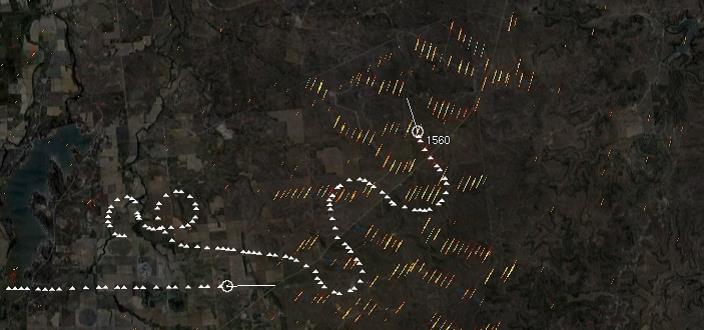 Wind turbines can cause interference to the radar signals that air traffic controllers use to direct aircraft. Turbine blades can appear as clutter on radar screens and be mistaken for aircraft.
Wind turbines can cause interference to the radar signals that air traffic controllers use to direct aircraft. Turbine blades can appear as clutter on radar screens and be mistaken for aircraft.
It was announced from Aarhus, Denmark, on 7 October that Terma’s SCANTER 4002 radar system forms part of a turnkey surveillance solution to mitigate the impact of the 19 turbine 50MW onshore Frodsham Wind Farm Ltd., owned by Peel Energy and Belltown Power, on the radar systems at both Chester Hawarden and Liverpool John Lennon airports. The equipment will be delivered into service in February 2016, it is understood. The airports are facing the Irish Sea on Britain’s mid-west coast.
This pdf introduces earlier wind turbine radar trials.
Transas maritime training
in the Philippines
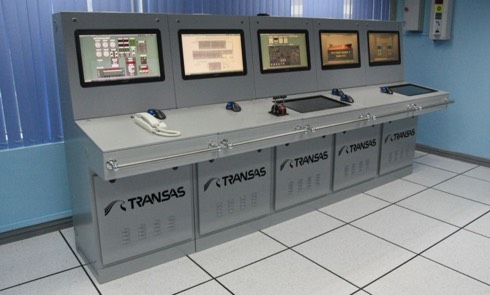
The rapid growth and development of the Philippine maritime training market caused a dramatic increase in demand for state-of-the-art simulation systems compliant with the latest MARINA and Commission on Higher Education (CHED) training requirements. This was stated in news from Transas Marine Limited on 1 October.
In order to enhance its range of services offered to the MET organisations in the Philippines, Transas has partnered with Philippine Lifesaving Equipment Inc., a local company with vast experience in the maritime market. Together, the companies are providing training for the Philippine market compliant with all international, as well as local, standards set by the Maritime Industry Authority of the Philippines (MARINA).
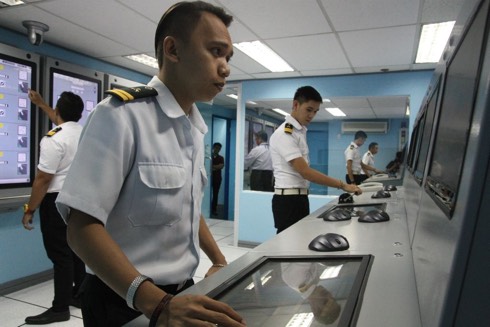
The Navigator – Nº 10
The Navigator, the aim of which is to inspire professionalism in marine navigators, is produced by The Nautical Institute in association with the Royal Institute of Navigation and appears every four months, that is February, June and October.
It is available in print form and may be downloaded in high resolution (4.39MB) and low resolution (855KB) pdf versions from the Nautical Institute’s website
exactEarth launches advanced equatorial AIS satellite
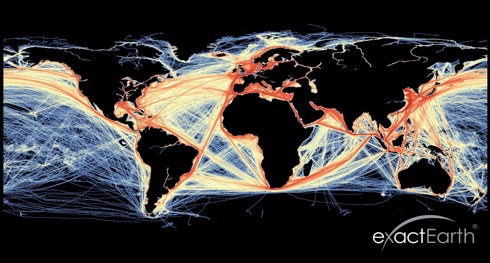 This is a record of global shipping density and shows traffic from one typical month and highlights the busy tropical shipping regions for which exactEarth’s new equatorial satellite will provide expanded and detailed coverage. – Reproduced by kind permission of exactEarth©
This is a record of global shipping density and shows traffic from one typical month and highlights the busy tropical shipping regions for which exactEarth’s new equatorial satellite will provide expanded and detailed coverage. – Reproduced by kind permission of exactEarth©
It was announced from Cambridge, Ontario, Canada on 28 September that exactEarth Ltd., a leading provider of satellite AIS data services, reported the successful launch of an advanced AIS satellite, known as exactView-9 (EV9), thereby expanding its exactView™ global vessel monitoring constellation to eight in-orbit satellites.
This spacecraft was built by the University of Toronto Institute for Aerospace Studies Space Flight Laboratory and launched from the Satish Dhawan Space Centre in Sriharikota in India on 28 September aboard the Indian Space Research Organizations (ISRO) PSLV-C30 rocket.
Complementing the existing polar orbiting satellites of the exactEarth constellation, EV9 orbits around the equator every 97 minutes providing expanded and detailed coverage to the busy tropical shipping regions of the world.
Russian icebreaker innovation NEVA 2015
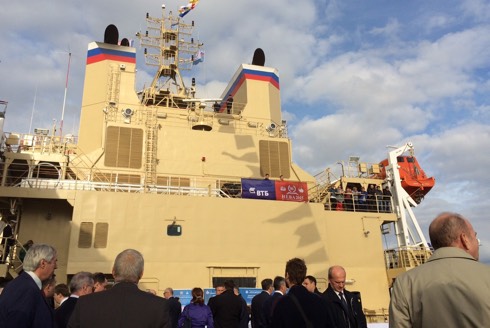
A spectacular ceremony (pictured) was held on the lead vessel of the icebreaker project 21900M in St. Petersburg on 23 September, forming part of the NEVA 2015 Programme. Guests and dignitaries came together to witness the official
flag-raising ceremony on board the icebreaker Vladivostok, seen here, and to celebrate all those involved in the project.
The diesel-powered icebreaker 21900M project, a modification of project 21900, was laid down at the Vyborg Shipyard in October 2012. Vladivstok is
the lead vessel in the series of three diesel-electric icebreakers built for FSUE
Rosmorport and classed by the Russian Maritime Register of Shipping.
Vladivostok is able to overcome ice thickness of up to 1.5 metres and her main purpose is the independent escort of large capacity vessels, towing,
extinguishing fires on floating facilities and other structures, providing
assistance to ships in distress, and the transport of cargo.
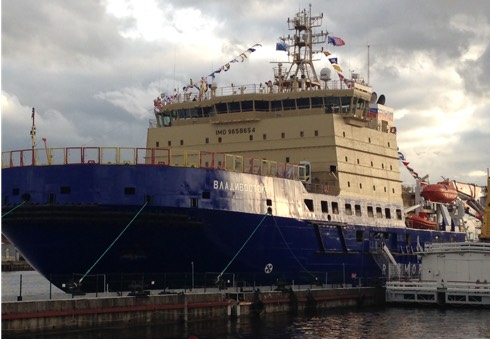
International Maritime Transport & Technology Conference

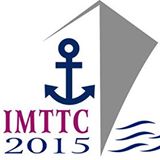
News has been received of this event organised by the College of Maritime Transport & Technology (CMTT) to be held at the Arab Academy for Science, Technology & Maritime Transport, Abu Qir, Alexandria, Egypt.
IMTTC 2015 aims to bring together researchers and practitioners working in the maritime industry and academia to provide them with a platform to report on the latest developments, achievements, deployments, technology trends and research findings as well as initiatives related to maritime transport and technology.
More details and a call for papers at the conference page: http://imttc.aast.edu.
Resilient PNT Forum IV
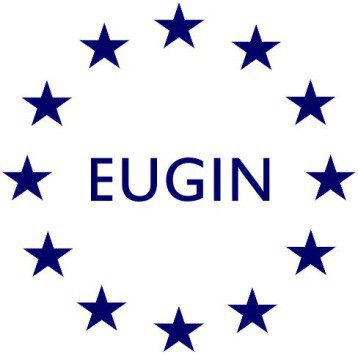
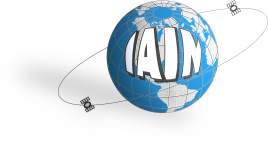
![]()
The International Association of Institutes of Navigation (IAIN) holds its Congress in Prague from 20-24 October 2015. The fourth Forum on Resilient Positioning, Navigation and Timing (PNT) will be held from 1600-1800 on 20 October 2015, immediately preceding the Conference in the same venue.
This follows three very successful events at ENC 2014 in Rotterdam, at ION ITM 2015 at Dana Point California and at ENC 2015 in Bordeaux. The motivation for these events is the increasing reliance on Global Navigation Satellite Systems in all transport sectors, for timing and other essential infrastructure throughout the World.
Note: there is no charge for this event, those wishing to attend are invited to register their interest with the organisers, nick-dot-ward-at-gla-hyphen-rrnav-dot-org
The day’s programme can be found here.
Resilient PNT Forum IV
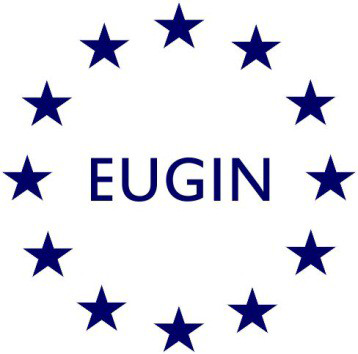

![]()
The International Association of Institutes of Navigation (IAIN) holds its Congress in Prague from 20-24 October 2015. The fourth Forum on Resilient Positioning, Navigation and Timing (PNT) will be held from 1600-1800 on 20 October 2015, immediately preceding the Conference in the same venue.
This follows three very successful events at ENC 2014 in Rotterdam, at ION ITM 2015 at Dana Point California and at ENC 2015 in Bordeaux. The motivation for these events is the increasing reliance on Global Navigation Satellite Systems in all transport sectors, for timing and other essential infrastructure throughout the World.
Note: there is no charge for this event, those wishing to attend are invited to register their interest with the organisers, nick-dot-ward-at-gla-hyphen-rrnav-dot-org
The day’s programme can be found here.
World Maritime Day 2015
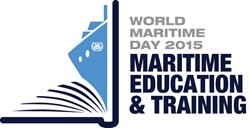
The World Maritime Day theme for 2015 is ‘Maritime education and training’. This was adopted to focus attention on the wider spectrum of maritime education and training, in particular its adequacy and quality, as the bedrock of a safe and secure shipping industry, which needs to preserve the quality, practical skills and competence of qualified human resources, in order to ensure sustainability.
At the International Maritime Organization (IMO) the 1978 STCW Convention and Code, as amended, set the international benchmark for the training and education of seafarers. While compliance with its standards is essential for serving on board ships, the skills and competence of seafarers, and indeed, the human element ashore, can only be adequately underpinned, updated and maintained through effective maritime education and training.
Although World Maritime Day will be celebrated at IMO Headquarters on 24 September other events and activities focusing on maritime education and training are being held throughout the year.
Red Arrows farewell to Vulcan
 © Crown 2015
© Crown 2015
The Royal Air Force Red Arrows have flown with the Vulcan bomber for the final time in a show of great British aviation icons. Jets from the Royal Air Force Aerobatic Team performed a flypast with the mighty Cold War aircraft at the Southport Air Show, on Britain’s north-west coast on 19 September.
Thousands of people cheered and waved as the Red Arrows’ nine distinctive
British- built Hawk aircraft made a V-shape ahead of the Vulcan. This striking formation flew over water, along the coast, having joined up over the sea about ten miles from Prestatyn. It was the highlight of the air show, at which both the Vulcan and Red Arrows also displayed individually.
Battle of Britain heroes honoured at Westminster
Abbey service
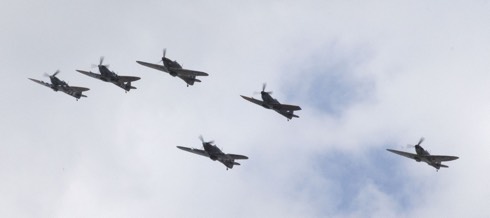 © Crown 2015
© Crown 2015
The extraordinary feats of the Royal Air Force’s Battle of Britain heroes, who fought to save Britain from invasion 75 years ago, were honoured during a special service at Westminster Abbey on 20 September. The Service of Thanksgiving and Rededication, led by The Very Reverend Dr John Hall, Dean of Westminster, saw veterans parade through the Abbey with the Battle of Britain Roll of Honour – listing the 2,936 aircrew who fought in the Battle – and included readings from RAF personnel including Chaplain-in-Chief, The Venerable Jonathan Chaffey, and others.
After the service onlookers were treated to a six-ship flypast illustrated), over the Abbey as two Hurricanes and four Spitfires from RAF Coningsby’s Battle of Britain Memorial Flight roared overhead.
Taking a look
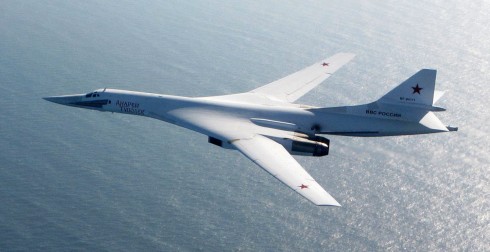 © Crown Copyright 2015
© Crown Copyright 2015
The UK Ministry of Defence announced on 11 September that Royal Air Force Typhoon jets had flown from RAF Lossiemouth in Scotland to intercept Russian ‘Blackjack’ aircraft flying in international air space.
 © Crown Copyright 2015
© Crown Copyright 2015
Terma launches new naval radar
 Fine-tuning a SCANTER radar system
Fine-tuning a SCANTER radar system
It was announced from Aarhus, Denmark, on 11 September that Terma will be introducing its latest naval radar at the Defence & Security Equipment International (DSEI) 2015 to be held at London’s EXCEL from 15 to 18 September.
TERMA will introduce its new C-Flex COMPACT Mission System for smaller vessels. It provides situational awareness, supports efficient planning and decision making, and contains tools for intelligence and legal evidence collection. Its capabilities are derived from Terma’s full C-Flex CMS range and thus has a very solid base it is understood.
ICAO Secretary General
fosters new cooperative ties
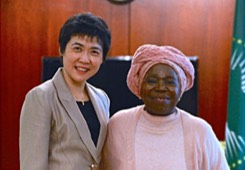
An ICAO Delegation led by Secretary General Dr Fang Liu, and including ICAO’s Regional Director for Western and Central Africa, Mr Mam Sait Jallow, and its Regional Director for Eastern and Southern Africa, Mr Barry Kashambo, visited Nairobi, Kenya, and Addis Ababa, Federal Democratic Republic of Ethiopia, from 18-20 August 2015. This was reported from ICAO HQ in Montreal on 27 August.
On 19 August Secretary General Liu met HE Dr Nkosazana Dlamini-Zuma, Chairperson of the African Union Commission (AUC). Also present at the meeting was Mr Mankopane Daniel Tshepo Peege, Representative of South Africa on the ICAO Council. Their fruitful and friendly discussions covered the ongoing implementation of the Memorandum of Cooperation signed by the two organizations in 2010, as well as various goals common to ICAO’s current Strategic Objectives and the AU Agenda 2063. Skilled personnel training and technical assistance priorities were also high on the two leaders’ agendas.
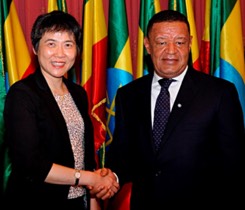 ICAO Secretary General, Dr Fang Liu, meeting with the Chairperson of the African Union Commission, HE Dr Nkosazana Dlamini-Zuma (photo top, left), and the President of Ethiopia, HE Dr Mulatu Teshome Wirtu (photo bottom, right), during her recent mission to Addis Ababa and Nairobi. – Photo ©ICAO.
ICAO Secretary General, Dr Fang Liu, meeting with the Chairperson of the African Union Commission, HE Dr Nkosazana Dlamini-Zuma (photo top, left), and the President of Ethiopia, HE Dr Mulatu Teshome Wirtu (photo bottom, right), during her recent mission to Addis Ababa and Nairobi. – Photo ©ICAO.
Aids to navigation workshop Africa
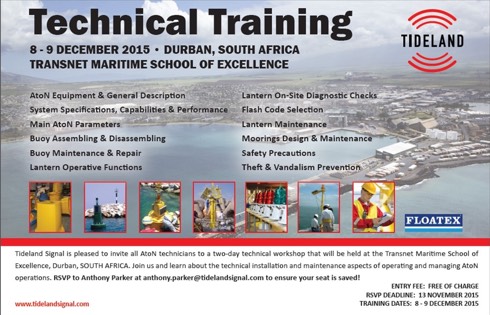
Anthony Parker, Sales Manager – Sub-Saharan Africa of Tideland Signal Limited based in Burgess Hill, West Sussex, in the UK reports that his company will be organising an aids to navigation workshop for Africa.
Training will take place at Transnet Port Authority, Durban, South Africa on 8 & 9 December, 2015 with the objective of familiarising those who attend with aids to navigation functions and maintenance in order to optimise equipment capabilities and performance, observing recommended safety precautions.
The instructors are three factory-trained aids to navigation engineers and 20 to 30 participants are anticipated.
EGNOS services ensured long term

The European GNSS Agency (GSA) announced on 2 September that after extensive ground and space testing, SES-5 GEO satellite has now entered into European Geostationary Navigation Overlay Service (EGNOS) operational platform broadcasting EGNOS Signal-In-Space (SIS).
EGNOS is operated by the European Satellite Services Provider (ESSP), under contract by the GSA on behalf of the European Commission. SES-5 – which replaces Inmarsat-4F2 – will ensure reliable EGNOS services until 2026. It has been introduced through EGNOS System Release V241M, which will enable a range of performance improvements. In particular, EGNOS will offer even greater stability during periods of high ionospheric activity.
ESA’s introduction to EGNOS.
Finavia to train Estonian ATC
Finavia Corporation has signed an agreement on air traffic controller training with Lennuliiklusteeninduse AS (EANS), a company responsible for air navigation services in Estonia. EANS will acquire an air control course from Finavia in order to obtain additional staff. This was reported by Finavia in Vantaa, Finland on 1 September.
EANS organised a bidding process for international training providers in order to urgently fill its increasing service needs with skilled professionals. Finaviabased Avia College will train seven Estonian air control students during the next air traffic controller course. The strength of Finnish air traffic controller training is its high-quality training programme focused on professional expertise which can be completed in 18 months.
 Finnish air traffic controller.
Finnish air traffic controller.
US NDGPS update
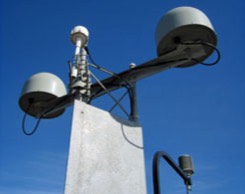 DGPS reference station anenna
DGPS reference station anenna
The (US) Nationwide Differential Global Positioning System (NDGPS) service augments GPS by providing increased accuracy and integrity using land-based reference stations to transmit correction messages over radiobeacon frequencies.
It is understood that a number of factors have contributed to declining use of NDGPS and, based on an assessment by the Department of Homeland Security (DHS), DOT, and USACE, DHS, DOT, and USACE are proposing to shutdown and decommission 62 DGPS sites, which will leave 22 operational sites available to users in coastal areas. A notice inviting public comment on the shutdown and decommissioning of these DGPS sites has been published and termination of the NDGPS broadcasts at these sites is planned to occur on 15 January 2016.
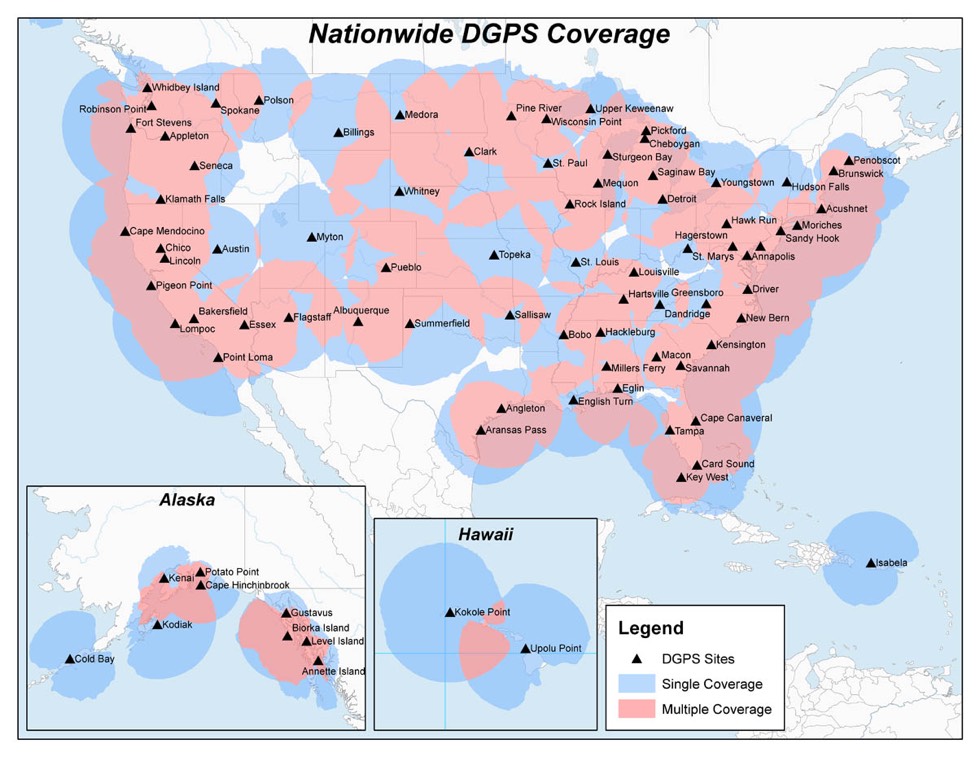 NDGPS coverage
NDGPS coverage
Galileo launch preparation
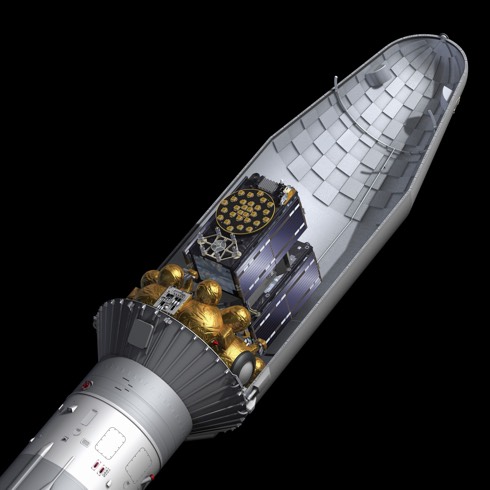 Cutaway view of the Soyuz rocket fairing carrying a pair of Galileo satellites. – photo © ESA – J. Huart, 2014
Cutaway view of the Soyuz rocket fairing carrying a pair of Galileo satellites. – photo © ESA – J. Huart, 2014
Europe’s latest Galileo satellites are fully fuelled, leaving them ready to be attached to their launcher upper stage in preparation for their 11 September launch, it was reported by the European Space Agency (ESA) on 28 August.
Galileo 9 and 10 are due to launch atop a Soyuz launcher at 0408 GMT on 11 September from Europe’s Spaceport in French Guiana.
Technicians donned SCAPE (Self Contained Atmospheric Protective Ensemble) suits to fill each satellite with sufficient hydrazine fuel for their planned twelve years of operations in space. This fuel is needed for fine-tuning of their orbital paths following their launch, followed by routine orbital and attitude control in the course of their working lives.
Each Galileo satellite needs to keep its navigation antenna trained on Earth’s disc at all times, employing dedicated infrared Earth and Sun sensors for this purpose.
This marked the first time Galileo had been fuelled within the Guiana Space Centre’s 3SB preparation building. Previously the S5 fuelling building was dedicated to this purpose, but upgrades by Arianespace mean fuelling can now take place at the same location where they will subsequently be attached to their Fregat upper stage, streamlining the satellite preparation process.

